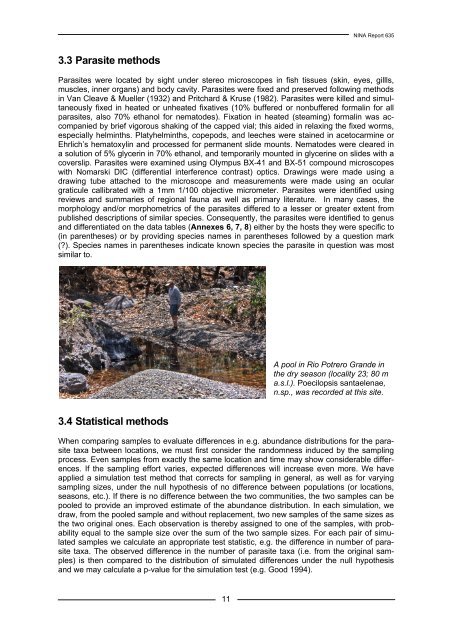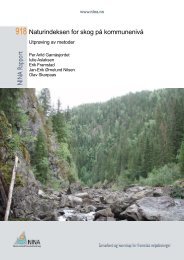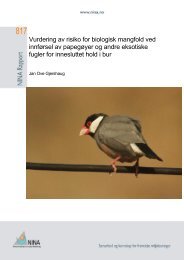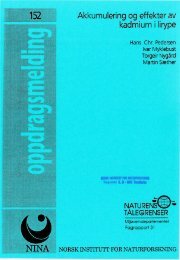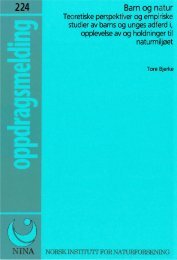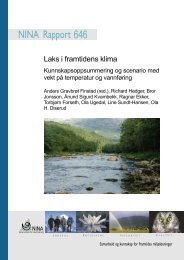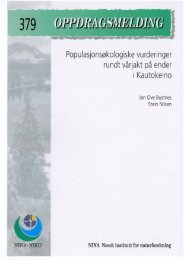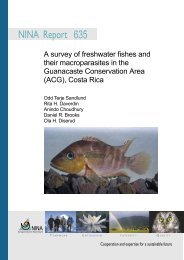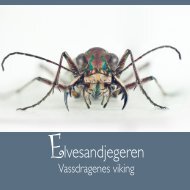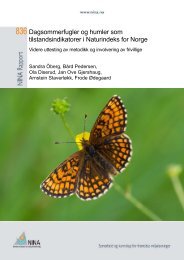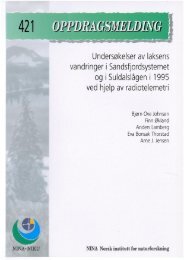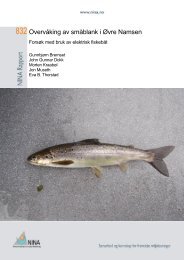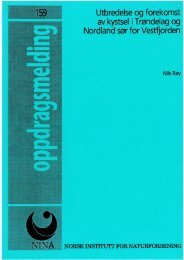A survey of freshwater fishes and their macroparasites in the ... - NINA
A survey of freshwater fishes and their macroparasites in the ... - NINA
A survey of freshwater fishes and their macroparasites in the ... - NINA
You also want an ePaper? Increase the reach of your titles
YUMPU automatically turns print PDFs into web optimized ePapers that Google loves.
3.3 Parasite methods<br />
11<br />
<strong>NINA</strong> Report 635<br />
Parasites were located by sight under stereo microscopes <strong>in</strong> fish tissues (sk<strong>in</strong>, eyes, gillls,<br />
muscles, <strong>in</strong>ner organs) <strong>and</strong> body cavity. Parasites were fixed <strong>and</strong> preserved follow<strong>in</strong>g methods<br />
<strong>in</strong> Van Cleave & Mueller (1932) <strong>and</strong> Pritchard & Kruse (1982). Parasites were killed <strong>and</strong> simultaneously<br />
fixed <strong>in</strong> heated or unheated fixatives (10% buffered or nonbuffered formal<strong>in</strong> for all<br />
parasites, also 70% ethanol for nematodes). Fixation <strong>in</strong> heated (steam<strong>in</strong>g) formal<strong>in</strong> was accompanied<br />
by brief vigorous shak<strong>in</strong>g <strong>of</strong> <strong>the</strong> capped vial; this aided <strong>in</strong> relax<strong>in</strong>g <strong>the</strong> fixed worms,<br />
especially helm<strong>in</strong>ths. Platyhelm<strong>in</strong>ths, copepods, <strong>and</strong> leeches were sta<strong>in</strong>ed <strong>in</strong> acetocarm<strong>in</strong>e or<br />
Ehrlich’s hematoxyl<strong>in</strong> <strong>and</strong> processed for permanent slide mounts. Nematodes were cleared <strong>in</strong><br />
a solution <strong>of</strong> 5% glycer<strong>in</strong> <strong>in</strong> 70% ethanol, <strong>and</strong> temporarily mounted <strong>in</strong> glycer<strong>in</strong>e on slides with a<br />
coverslip. Parasites were exam<strong>in</strong>ed us<strong>in</strong>g Olympus BX-41 <strong>and</strong> BX-51 compound microscopes<br />
with Nomarski DIC (differential <strong>in</strong>terference contrast) optics. Draw<strong>in</strong>gs were made us<strong>in</strong>g a<br />
draw<strong>in</strong>g tube attached to <strong>the</strong> microscope <strong>and</strong> measurements were made us<strong>in</strong>g an ocular<br />
graticule callibrated with a 1mm 1/100 objective micrometer. Parasites were identified us<strong>in</strong>g<br />
reviews <strong>and</strong> summaries <strong>of</strong> regional fauna as well as primary literature. In many cases, <strong>the</strong><br />
morphology <strong>and</strong>/or morphometrics <strong>of</strong> <strong>the</strong> parasites differed to a lesser or greater extent from<br />
published descriptions <strong>of</strong> similar species. Consequently, <strong>the</strong> parasites were identified to genus<br />
<strong>and</strong> differentiated on <strong>the</strong> data tables (Annexes 6, 7, 8) ei<strong>the</strong>r by <strong>the</strong> hosts <strong>the</strong>y were specific to<br />
(<strong>in</strong> paren<strong>the</strong>ses) or by provid<strong>in</strong>g species names <strong>in</strong> paren<strong>the</strong>ses followed by a question mark<br />
(?). Species names <strong>in</strong> paren<strong>the</strong>ses <strong>in</strong>dicate known species <strong>the</strong> parasite <strong>in</strong> question was most<br />
similar to.<br />
3.4 Statistical methods<br />
A pool <strong>in</strong> Rio Potrero Gr<strong>and</strong>e <strong>in</strong><br />
<strong>the</strong> dry season (locality 23; 80 m<br />
a.s.l.). Poecilopsis santaelenae,<br />
n.sp., was recorded at this site.<br />
When compar<strong>in</strong>g samples to evaluate differences <strong>in</strong> e.g. abundance distributions for <strong>the</strong> parasite<br />
taxa between locations, we must first consider <strong>the</strong> r<strong>and</strong>omness <strong>in</strong>duced by <strong>the</strong> sampl<strong>in</strong>g<br />
process. Even samples from exactly <strong>the</strong> same location <strong>and</strong> time may show considerable differences.<br />
If <strong>the</strong> sampl<strong>in</strong>g effort varies, expected differences will <strong>in</strong>crease even more. We have<br />
applied a simulation test method that corrects for sampl<strong>in</strong>g <strong>in</strong> general, as well as for vary<strong>in</strong>g<br />
sampl<strong>in</strong>g sizes, under <strong>the</strong> null hypo<strong>the</strong>sis <strong>of</strong> no difference between populations (or locations,<br />
seasons, etc.). If <strong>the</strong>re is no difference between <strong>the</strong> two communities, <strong>the</strong> two samples can be<br />
pooled to provide an improved estimate <strong>of</strong> <strong>the</strong> abundance distribution. In each simulation, we<br />
draw, from <strong>the</strong> pooled sample <strong>and</strong> without replacement, two new samples <strong>of</strong> <strong>the</strong> same sizes as<br />
<strong>the</strong> two orig<strong>in</strong>al ones. Each observation is <strong>the</strong>reby assigned to one <strong>of</strong> <strong>the</strong> samples, with probability<br />
equal to <strong>the</strong> sample size over <strong>the</strong> sum <strong>of</strong> <strong>the</strong> two sample sizes. For each pair <strong>of</strong> simulated<br />
samples we calculate an appropriate test statistic, e.g. <strong>the</strong> difference <strong>in</strong> number <strong>of</strong> parasite<br />
taxa. The observed difference <strong>in</strong> <strong>the</strong> number <strong>of</strong> parasite taxa (i.e. from <strong>the</strong> orig<strong>in</strong>al samples)<br />
is <strong>the</strong>n compared to <strong>the</strong> distribution <strong>of</strong> simulated differences under <strong>the</strong> null hypo<strong>the</strong>sis<br />
<strong>and</strong> we may calculate a p-value for <strong>the</strong> simulation test (e.g. Good 1994).


